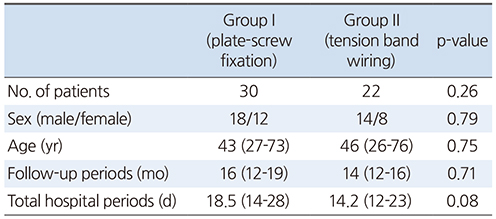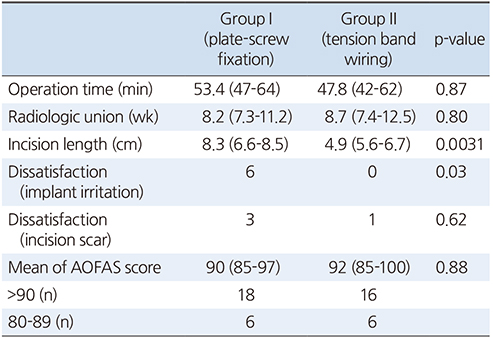Articles
- Page Path
- HOME > J Musculoskelet Trauma > Volume 33(1); 2020 > Article
- Original Article Treatment of Isolated Lateral Malleolar Fractures Using Locking Compression Plate Fixation and Tension Band Wiring Fixation
- Woojin Shin, Seondo Kim, Jiyeon Park
-
Journal of Musculoskeletal Trauma 2020;33(1):16-21.
DOI: https://doi.org/10.12671/jkfs.2020.33.1.16
Published online: January 31, 2020

- 691 Views
- 6 Download
- 0 Crossref
- 0 Scopus
Abstract
PURPOSE
The purpose of this study was to compare the clinical and radiological outcomes of locking compression plate (LCP)-screw fixation and tension band wiring (TBW) fixation in isolated lateral malleolar fractures.
MATERIALS AND METHODS
From May 2016 to August 2018, 52 patients with isolated lateral malleolar fracture were retrospectively reviewed. They were divided into 30 cases of the LCP fixation group (Group I) and 22 cases of the TBW fixation group (Group II). The clinical and radiological results of those groups were compared. Pearson chi-square tests and independent t-tests were used in the statistical analysis.
RESULTS
The mean length of the surgical incision was 8.3 cm in Group I and 4.9 cm in Group II. Radiological union was obtained at a mean of 8.4 weeks in both groups. The mean American Orthopaedic Foot and Ankle Society score was 90 (range, 85–97) and 92 (range, 85–100) in Groups I and II, respectively, at the last follow up.
CONCLUSION
Both the LCP-screw and TBW techniques revealed excellent results in isolated lateral malleolar fractures. The tension band technique may be a fine alternative method of fixation in the treatment of isolated lateral malleolar fracture.
Published online Jan 23, 2020.
https://doi.org/10.12671/jkfs.2020.33.1.16
Treatment of Isolated Lateral Malleolar Fractures Using Locking Compression Plate Fixation and Tension Band Wiring Fixation
Abstract
Purpose
The purpose of this study was to compare the clinical and radiological outcomes of locking compression plate (LCP)-screw fixation and tension band wiring (TBW) fixation in isolated lateral malleolar fractures.
Materials and Methods
From May 2016 to August 2018, 52 patients with isolated lateral malleolar fracture were retrospectively reviewed. They were divided into 30 cases of the LCP fixation group (Group I) and 22 cases of the TBW fixation group (Group II). The clinical and radiological results of those groups were compared. Pearson chi-square tests and independent t-tests were used in the statistical analysis.
Results
The mean length of the surgical incision was 8.3 cm in Group I and 4.9 cm in Group II. Radiological union was obtained at a mean of 8.4 weeks in both groups. The mean American Orthopaedic Foot and Ankle Society score was 90 (range, 85–97) and 92 (range, 85–100) in Groups I and II, respectively, at the last follow up.
Conclusion
Both the LCP-screw and TBW techniques revealed excellent results in isolated lateral malleolar fractures. The tension band technique may be a fine alternative method of fixation in the treatment of isolated lateral malleolar fracture.
Fig. 1
(A) A 54-year-old female patient was diagnosed with isolated lateral malleolar fracture according to the simple radiography. (B) Surgical fixation with locking-plate screw on the postoperative radiography. (C) Bone-union was achieved within 12 months of surgery.
Fig. 2
(A) A 32-year-old male patient was diagnosed with isolated lateral malleolar fracture according to the simple radiography. (B) Surgical fixation with the tension band wire on the postoperative radiography. (C) Bone-union was achieved within 12 months of surgery.
Table 1
Baseline Characteristics and Demographics
Table 2
Operation-Related Data Analysis
Financial support:None.
Conflict of interests:None.
References
-
Lindsjö U. Operative treatment of ankle fracture-dislocations. A follow-up study of 306/321 consecutive cases. Clin Orthop Relat Res 1985;(199):28–38.
-
-
Winkler B, Weber BG, Simpson LA. In: Planning and reduction technique in fracture surgery. New York: Springer-Verlag; 1989. pp. 735-762.
-

 E-submission
E-submission KOTA
KOTA TOTA
TOTA TOTS
TOTS






 PubReader
PubReader Cite
Cite

